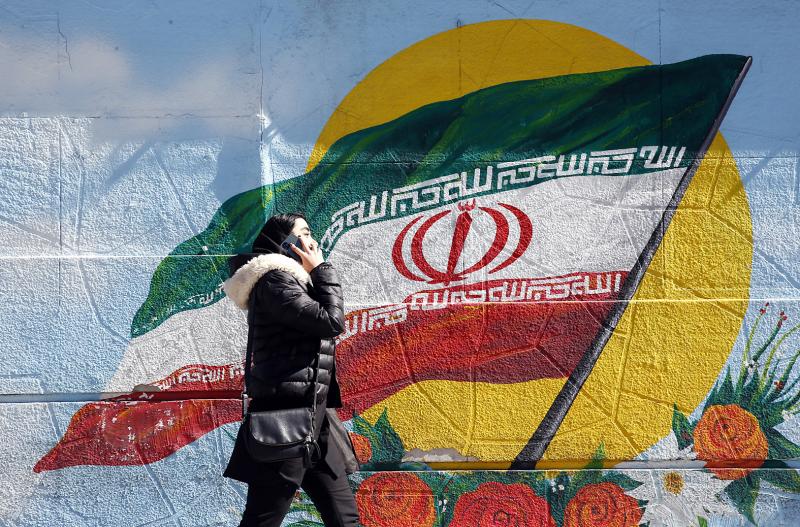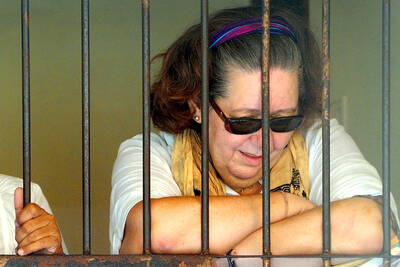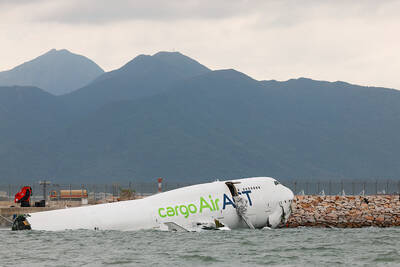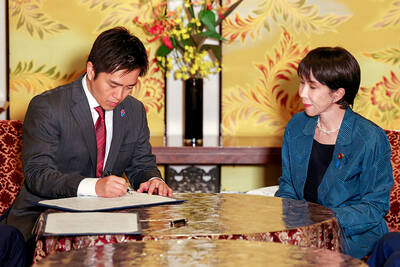After Iran last month imposed an Internet shutdown lasting several days in a southeastern region during a rare upsurge of unrest, advocates said the government is now using the tactic repeatedly when protests erupt.
Rights groups have said at least 10 people were killed when security forces opened fire on fuel porters in Saravan, Sistan-Baluchistan Province, on Feb. 22, prompting protests where live ammunition was used on unarmed demonstrators.
However, little information filtered out due to a near-total shutdown of the Internet in the impoverished region bordering Pakistan, which has a large ethnic Baluch population and has been a flashpoint for cross-border attacks by separatists and Sunni extremists.

Photo: EPA-EFE
The Internet shutdown was a “measure authorities appear to be using as a tool to conceal gross human rights violations and possible international crimes such as extrajudicial killings,” freedom of expression groups Access Now, Article 19 and Miaan Group said in a joint statement with Amnesty International.
Campaigners said such shutdowns, which recall those seen in the past few months during street protests in Belarus and Myanmar, have a dual purpose.
They seek to prevent people from using social media messaging services to mobilize protests, but also hinder the documentation of rights violations that could be used to rally support at home and abroad.
Iran in November 2019 imposed nationwide Internet limits during rare protests against fuel hikes that the authorities suppressed in a deadly crackdown. Rights groups fear the same tactic risks being used again during potentially tense presidential elections this summer.
The Sistan-Baluchistan shutdown saw mobile Internet services halted, effectively shutting down the Web in an area where mobile phones account for more than 95 percent of Internet use.
“It is aimed at harming documentation and the ability of people to mobilize and coordinate,” Mahsa Alimardani, Iran researcher with the Article 19 freedom of expression group, told reporters. “It helps the authorities to be able to control the narrative.”
State media said there were attacks on government buildings in Saravan and that a policeman was killed when unrest spread to the provincial capital, Zahedan.
The governor of the city’s region, Abouzarmahdi Nakahei, denounced “fake” reports of deaths in the protests, blaming “foreign media.”
Alimardani said that targeting mobile Internet connections made the shutdown different from the one seen in November 2019.
Then, Iranians were cut off from international Internet traffic, but were able to continue highly filtered activities on Iran’s homegrown Internet platform the National Information Network.
She said the documentation of atrocities was the authorities’ biggest fear.
“It is a big rallying call when these videos go viral,” she said.
Unlike some other minority groups in Iran, such as Arabs and Kurds, the Baluch do not have major representation in the West to promote their cause and draw attention to alleged violations on social media.
Most Baluch adhere to the Sunni branch of Islam rather than the Shiism dominant in Iran and rights groups also say Baluch convicts have been disproportionately targeted by executions.
According to information received by Amnesty from Baluchi advocates, at least 10 people were killed on Febr. 22 when Revolutionary Guards “unlawfully and deliberately used lethal force” against unarmed Baluchi fuel porters near Saravan.
The crackdown came after the security forces blocked a road to impede the work of the porters, who cross between Iran and Pakistan to sell fuel.
Amnesty added that security forces also used unlawful and excessive force against people who protested in response to the killings, as well as bystanders, leaving another two dead.
Amnesty’s Iran researcher Raha Bahreini told reporters that the toll was a “minimum figure” that Baluchi advocates verified after confirming the victims’ names.
The New York-based Center for Human Rights in Iran (CHRI) have an even higher toll of 23 dead, citing local sources.
The Internet shutdown “severely restricted the flow of information to rights defenders from contacts and eyewitnesses,” Bahreini told reporters. “The authorities are fully aware they are preventing the outside world from learning about the extent and gravity of violations on the ground,” she added.
She said such unlawful shutdowns had turned into a “pattern” in Iran.
UN High Commissioner for Human Rights spokesman Rupert Colville said that the shutdown has impeded precise verification of the death toll and had “the apparent purpose of preventing access to information about what is happening there.”
Iran blocked Internet access “to kill protesters indiscriminately and out of the public eye, and prevent protesters from communicating and organizing, ” the CHRI said.
“Security forces killed hundreds of protesters with impunity in November 2019, and they are doing it again now,” CHRI director Hadi Ghaemi said.

Indonesia was to sign an agreement to repatriate two British nationals, including a grandmother languishing on death row for drug-related crimes, an Indonesian government source said yesterday. “The practical arrangement will be signed today. The transfer will be done immediately after the technical side of the transfer is agreed,” the source said, identifying Lindsay Sandiford and 35-year-old Shahab Shahabadi as the people being transferred. Sandiford, a grandmother, was sentenced to death on the island of Bali in 2013 after she was convicted of trafficking drugs. Customs officers found cocaine worth an estimated US$2.14 million hidden in a false bottom in Sandiford’s suitcase when

CAUSE UNKNOWN: Weather and runway conditions were suitable for flight operations at the time of the accident, and no distress signal was sent, authorities said A cargo aircraft skidded off the runway into the sea at Hong Kong International Airport early yesterday, killing two ground crew in a patrol car, in one of the worst accidents in the airport’s 27-year history. The incident occurred at about 3:50am, when the plane is suspected to have lost control upon landing, veering off the runway and crashing through a fence, the Airport Authority Hong Kong said. The jet hit a security patrol car on the perimeter road outside the runway zone, which then fell into the water, it said in a statement. The four crew members on the plane, which

Japan’s ruling Liberal Democratic Party (LDP) and its junior partner yesterday signed a coalition deal, paving the way for Sanae Takaichi to become the nation’s first female prime minister. The 11th-hour agreement with the Japan Innovation Party (JIP) came just a day before the lower house was due to vote on Takaichi’s appointment as the fifth prime minister in as many years. If she wins, she will take office the same day. “I’m very much looking forward to working with you on efforts to make Japan’s economy stronger, and to reshape Japan as a country that can be responsible for future generations,”

SEVEN-MINUTE HEIST: The masked thieves stole nine pieces of 19th-century jewelry, including a crown, which they dropped and damaged as they made their escape The hunt was on yesterday for the band of thieves who stole eight priceless royal pieces of jewelry from the Louvre Museum in the heart of Paris in broad daylight. Officials said a team of 60 investigators was working on the theory that the raid was planned and executed by an organized crime group. The heist reignited a row over a lack of security in France’s museums, with French Minister of Justice yesterday admitting to security flaws in protecting the Louvre. “What is certain is that we have failed, since people were able to park a furniture hoist in the middle of